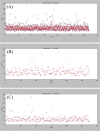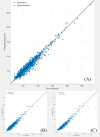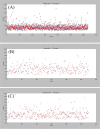Development of prediction models to estimate extubation time and midterm recovery time of ophthalmic patients undergoing general anesthesia: a cross-sectional study
- PMID: 36932318
- PMCID: PMC10022177
- DOI: 10.1186/s12871-023-02021-3
Development of prediction models to estimate extubation time and midterm recovery time of ophthalmic patients undergoing general anesthesia: a cross-sectional study
Abstract
Background: To develop prediction models for extubation time and midterm recovery time estimation in ophthalmic patients who underwent general anesthesia.
Methods: Totally 1824 ophthalmic patients who received general anesthesia at Joint Shantou International Eye Center were included. They were divided into a training dataset of 1276 samples, a validation dataset of 274 samples and a check dataset of 274 samples. Up to 85 to 87 related factors were collected for extubation time and midterm recovery time analysis, respectively, including patient factors, anesthetic factors, surgery factors and laboratory examination results. First, multiple linear regression was used for predictor selection. Second, different methods were used to develop predictive models for extubation time and midterm recovery time respectively. Finally, the models' generalization abilities were evaluated using a same check dataset with MSE, RMSE, MAE, MAPE, R-Squared and CCC.
Results: The fuzzy neural network achieved the highest R-Squared of 0.956 for extubation time prediction and 0.885 for midterm recovery time, and the RMSE value was 6.637 and 9.285, respectively.
Conclusion: The fuzzy neural network developed in this study had good generalization performance in predicting both extubation time and midterm recovery time of ophthalmic patients undergoing general anesthesia.
Trial registration: This study is prospectively registered in the Chinese Clinical Trial Registry, registration number: CHiCRT2000036416, registration date: August 23, 2020.
Keywords: Delayed Emergence from Anesthesia; Extubation Time; Fuzzy Neural Network; Midterm Recovery Time; Prediction Model; Risk Factors.
© 2023. The Author(s).
Conflict of interest statement
The authors declare no competing interests.
Figures










Similar articles
-
Development of a Machine-Learning Model for Prediction of Extubation Failure in Patients with Difficult Airways after General Anesthesia of Head, Neck, and Maxillofacial Surgeries.J Clin Med. 2023 Jan 30;12(3):1066. doi: 10.3390/jcm12031066. J Clin Med. 2023. PMID: 36769713 Free PMC article.
-
Median effective concentration of remifentanil in target controlled infusion for smooth tracheal extubation during emergence from general anesthesia in elderly patients.J Clin Anesth. 2016 Jun;31:13-8. doi: 10.1016/j.jclinane.2015.12.046. Epub 2016 Mar 16. J Clin Anesth. 2016. PMID: 27185668 Clinical Trial.
-
Effect of intravenous oxycodone on the physiologic responses to extubation following general anesthesia.BMC Anesthesiol. 2021 May 12;21(1):146. doi: 10.1186/s12871-021-01350-5. BMC Anesthesiol. 2021. PMID: 33980184 Free PMC article. Clinical Trial.
-
Clinical practice of early extubation after liver transplantation.Hepatobiliary Pancreat Dis Int. 2012 Dec 15;11(6):577-85. doi: 10.1016/s1499-3872(12)60228-8. Hepatobiliary Pancreat Dis Int. 2012. PMID: 23232628 Review.
-
Review article: Extubation of the difficult airway and extubation failure.Anesth Analg. 2013 Feb;116(2):368-83. doi: 10.1213/ANE.0b013e31827ab572. Epub 2013 Jan 9. Anesth Analg. 2013. PMID: 23302983 Review.
Cited by
-
A visit to preanesthesia clinic can promote post-anesthesia early recovery in pediatric patients undergoing minor surgery: a retrospective study from a single center.BMC Anesthesiol. 2025 May 24;25(1):259. doi: 10.1186/s12871-025-03136-5. BMC Anesthesiol. 2025. PMID: 40413395 Free PMC article.
References
-
- Samad K, Khan M, Hameedullah, Khan FA, Hamid M, Khan FH. Unplanned prolonged postanaesthesia care unit length of stay and factors affecting it. J Pak Med Assoc. 2006;56(3):108–112. - PubMed
Publication types
MeSH terms
Associated data
LinkOut - more resources
Full Text Sources

